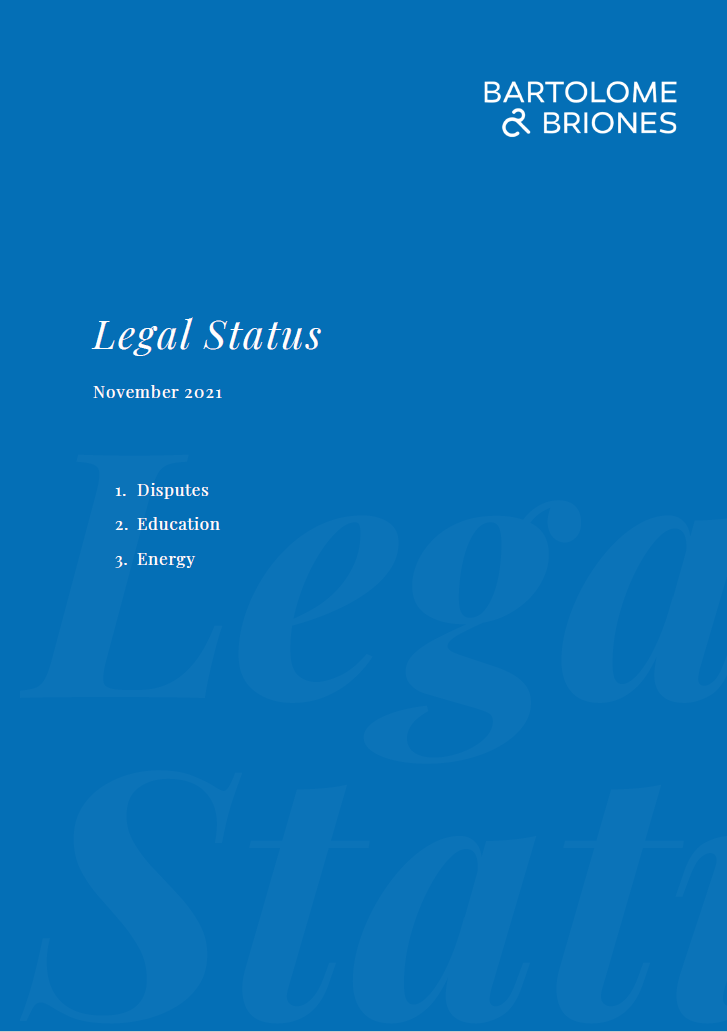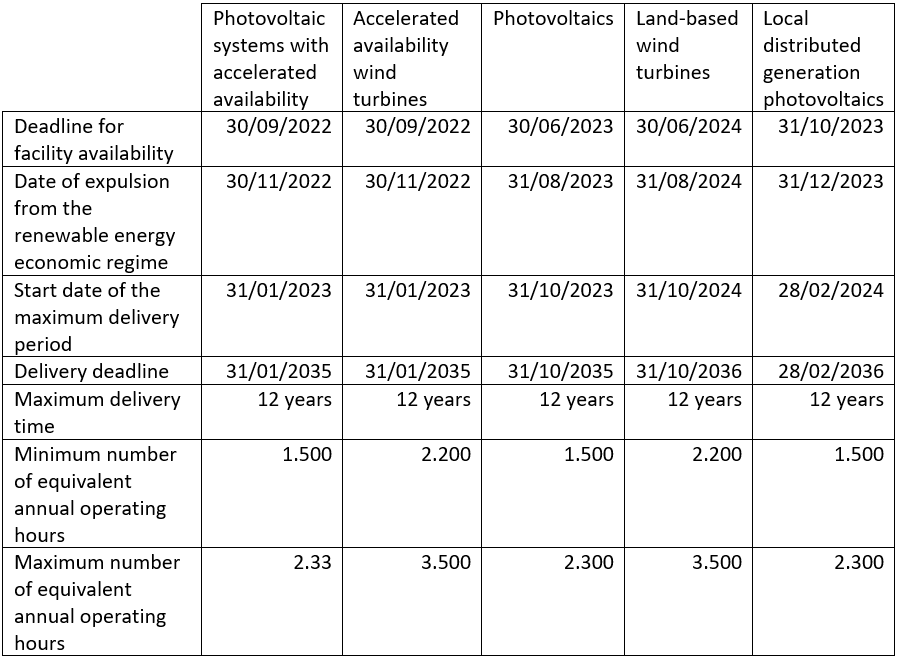Legal Status - NOVEMBER 2021
Disputes: Know-how: regulation and legal defence
Education: Use of copyright-protected material in the education sector
Energy: Analysis of the result of the second renewable energy auction of October 2021

DISPUTES
Know-how: regulation and legal defence
ANTONI FAIXÓ
Of counsel
The question of know-how has historically been the subject of debate and doctrinal analysis in law, due to the lack of specific legal regulation of it. However, efforts have been made to regulate it in recent years, especially following the initiative of the European Union. In Spain, Law 1/2019 on Business Secrets (hereinafter, LSE), which regulates this matter and its legal protection, is currently in force.
It is worth noting that know-how is not exactly the same as business secret given that it is broader in scope. However, for practical legal purposes, the LSE applies by extension to know-how and both concepts are defined by largely the same characteristics.
A trade secret is defined in the LSE as any information or knowledge, including technological, scientific, industrial, commercial, organisational or financial, which meets three conditions:
(a) It must be secret, in the sense that it is not generally known to the market.
(b) it must have business, i.e., economic, value.
(c) It must have been the subject of reasonable measures by its owner to keep it secret, i.e. to establish confidentiality or similar clauses in the licensing or assignment of use and work contracts.
Prior to this law, the protection of know-how was essentially carried out through two regulations: the Law on Unfair Competition, which regulates the violation of secrets as an act of unfair competition; and the Criminal Code, which regulates as crimes the illegal usurpation of a company secret and the disclosure of a company secret by anyone who was legally or contractually obliged to keep it.
The LSE has developed and specified new measures for the judicial protection of trade secrets (and know-how) in the civil sphere, establishing the following potential legal actions:
(1) The declaration of the violation of the trade secret.
(2) Cessation or prohibition of acts of infringement of trade secrets.
(3) Prohibition on manufacture or sale of infringing goods.
(4) Seizure of the infringing goods.
(5) Removal and, if necessary, destruction of documents and media containing the trade secret.
(6) The attribution of ownership of the infringing goods to the plaintiff, which may be set off against the compensation for damages.
(7) Compensation for damages if there is intent or fault on the part of the infringer.
(8) The full or partial publication of the judgment.
Furthermore, the law specifically regulates the preliminary proceedings that may be requested to verify facts and secure evidence, and the provisional measures that may be requested for the immediate cessation of the allegedly unlawful act; the retention of the infringing goods; and, where appropriate, the preventive seizure of goods to ensure the eventual compensation of damages.
The law also establishes a statute of limitations for legal action of three years from the date on which the entitled party became aware of the person who violated the business secret. It should be remembered that the generic time limit of the Civil Code for legal actions is five years, and so the shorter period that applies in this case must always be borne in mind.
The law also establishes that the judicial competence to deal with these proceedings corresponds to the Commercial Courts (which are only located in provincial capitals), and specifically to the one that the plaintiff chooses from the following possible ones: in the province where the defendant is domiciled, or in the province where the infringement has been committed or its effects have been produced.
Finally, for practical purposes, it is recommended to establish safeguards to reduce the risk of violation of business secrets or know-how, and which also serve as a means of obtaining evidence in the event of the infringing act: confidentiality and non-competition clauses in licensing and employment contracts; indemnity clauses for breach of the above; limitation and control of the use of applications on the company’s devices, and formalisation in a notarial record of the most significant information of the know-how.
November 2021
EDUCATION
Use of copyright-protected material in the education sector
DANAE BALCELLS
Associate
When we speak of the acquisition of companies in the educational sector, copyright plays an essential role. This is the case of those educational entities that provide the necessary material related to the education they provide to students. In practice, the purchaser must acquire the rights to exploit the educational materials, i.e., the rights of reproduction, distribution, public communication and transformation.
In some cases, the material may have been created by teachers within the scope of their employment contract. If so, the assignment of the copyright on the material must be set down in writing, failing which there is a presumption of exclusive assignment to the employer. In the event that the material has been created by a third party, the contractual agreement with the third party must be used to determine who owns the rights to exploit the material. In any case, the purchaser must acquire such rights. Furthermore, instances in which the author’s authorisation is not necessary to exploit the educational material should be taken into account, as Royal Legislative Decree 1/1996, of 12 April, approving the revised text of the Intellectual Property Law (hereinafter, “LPI”) establishes a series of exceptions for the educational sector, by virtue of which the author’s authorisation is not necessary to use the educational material.
Material created by an employee
If the author of the educational material has an employment relationship with the educational entity and creates works by virtue of their employment contract, unless otherwise agreed, the rights to such works shall be deemed to be assigned to the employer under Article 51 IPL.
Material created by a third party
In other cases, the company may have commissioned a third party to create the material, or acquired the rights to existing material from a third party, in which case the commissioning, publishing or assignment contract should be reviewed to ensure that all exploitation rights are held to ensure legitimate use of the educational materials.
The use of work not subject to authorization
Content for which the author’s authorisation to commercially exploit a copyrighted work is in any case not required can be of three types:
First, works subject to a “creative commons” licence, under which the author authorises the use of the work in its entirety. Second, if it is a work in the public domain, it means that the exploitation rights have expired due to the passage of time, usually the lifetime of the author plus seventy years since their death. In such cases, works may be freely used, provided that authorship is acknowledged, and their integrity is respected. Finally, orphan works do not require permission to be used either, as the author is unknown, and therefore also from whom permission must be sought. The only requirement is that the works must have been published or broadcast within the European Union.
Educational exceptions to copyright
In certain circumstances, the author’s permission is not required for the use of a work if the use is subject to an exception, such as, for example, the use of a quotation. In formal, meaning mandatory education, or informal education at universities, the author’s permission is not required for the partial reproduction, distribution and public communication of a book chapter, a journal article or 10% of the work used to illustrate the educational activity. Such an exception is only admissible where either partial copies of the work are distributed exclusively to students and staff within the educational establishment, or access to the work by acts of public communication, i.e. when the work is downloaded via internal and closed networks ensuring that only the students and staff concerned have access.
Finally, in both formal and informal education, teachers may avail themselves of the right of quotation to partially reproduce, distribute or communicate to the public a work by way of quotation or for analysis, commentary, or critical judgement within their own work.
Conclusion
In conclusion, when acquiring companies in the education sector, the particularities of the sector must be taken into account in order to ensure the continuity of the exploitation of educational materials. The material may have been created by employees and expressly or implicitly transferred to the employer or created by a third party and transferred, which makes the seller the holder of the exploitation rights. If the works are distributed under licences such as “creative commons” or are works in the public domain for which the copyright has expired, their use is not subject to any authorisation. Finally, use for illustration in educational activity is permitted on condition that exclusive use by students is ensured, and the right of quotation allows partial use of a work for analysis or criticism.
November 2021
ENERGY
Analysis of the result of the second renewable energy auction of October 2021
IGNACIO PUIG
Senior Associate
As we set out in the Legal Status of September 2021, the second auction for the granting of the Renewable Energy Economic Regime (“REER”) took place on 19 October 2021.
The result of the auction was published by the Directorate General for Energy Policy and Mines of the Ministry for Ecological Transition and the Demographic Challenge on 20 October 2021, pursuant to the provisions of Order TED/1161/2020, of 4 December.
The resolution includes the following information:
• A total of 61 agents submitted bids and 23 were awarded the contract.
• A total of 3,300 MW of power was auctioned and 5,100 MW were submitted; 54% more than the power auctioned.
• A total of 3,124 MW was awarded at 31.65 €/MWh for photovoltaic and 30.18 €/MWh for wind power. These prices are 60% below the long-term price estimate.
The following points are worth highlighting:
• The absence of major Spanish electricity companies such as Iberdrola, Endesa and Acciona, at a time of disagreements with the government over the regulation approved by Royal Decree-Law 17/2021, has affected the income of production facilities. Had the bid been submitted, it is likely that the power offered would have doubled, with an impact on the price of the auction
• According to industry sources, Capital Energy has won with the award of 1,550 MW (1,540 wind and 8 solar) (in the first auction it was awarded 620 MW); Forestalia has been awarded 776 MW, of which 576 MW are wind and 200 MW photovoltaic; Naturgy has been awarded 221 MW photovoltaic; and Repsol 138 MW wind.
The results contrast with the first auction, held on 26 January 2021 in a context of certain “stability” in the market:
• 84 agents participated, of which 32 were awarded the contract.
• A total of 3,000 MW of power was auctioned and 9,700 MW were offered, 323% more than the first auction.
• 3,034 MWh were awarded at an average price of 24.47 €/MWh for photovoltaic and 25.31 €/MWh for wind, 43% lower than the estimated long-term price at the time.
Furthermore, the parameters applicable to the successful bids in the second auction are also worth highlighting:

Finally, the 6,158 MW from the two auctions will be added, together with other renewable developments, to the 59,860 MW of the existing renewable generation park at the end of 2020, which already represented a share of renewable installed capacity of 54% of the total at that time. The target for 2030 according to Law 7/2021 of 20 May on climate change and energy transition is to achieve a penetration of renewable energies where at least 42 % of the energy consumed is renewable. Plus, have an electricity system capable to produce 74 % of the energy generation from renewable energies, and to improve energy efficiency by reducing primary energy consumption by at least 39.5 % in comparisonto the baseline according to the EU regulations.
November 2021
